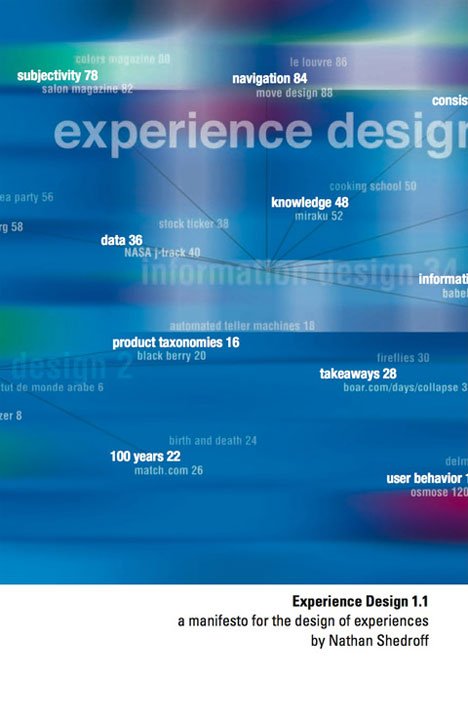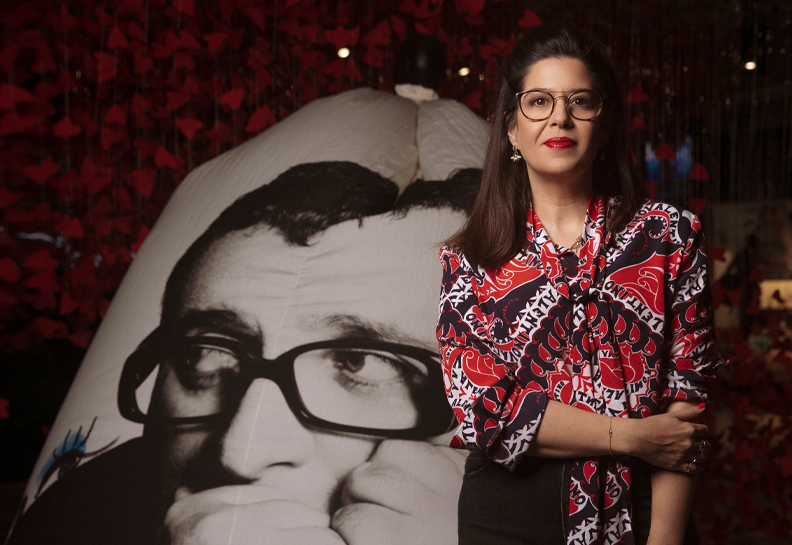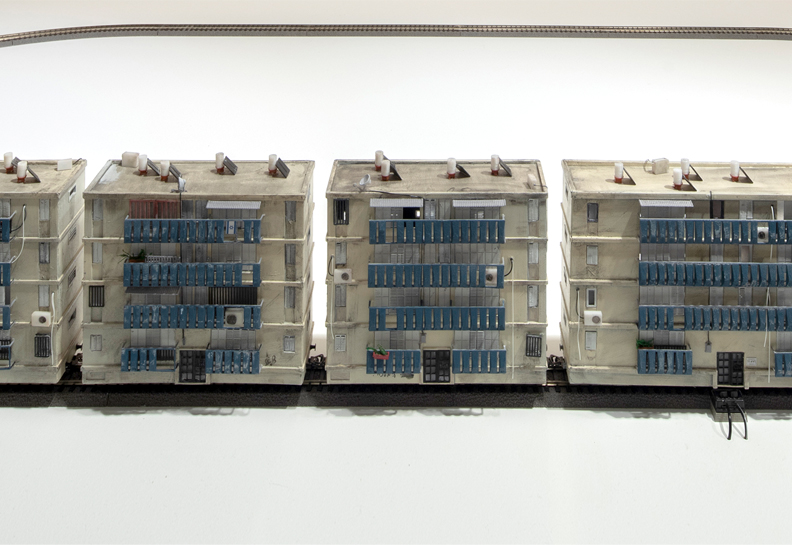Nathan Shedroff’s visit to Israel is an excellent opportunity to examine one of the subjects he is developing, namely Experience Design.
Experience Design 1.1 / Nathan ShedroffNathan Shedroff’s visit to Israel (for further information, see box) is an excellent opportunity to examine one of the subjects he is developing, namely Experience Design.
On the one hand this is a new field currently being defined, hence it has no history, and on the other it has existed since the dawn of history. Experience design is what we do every day and call “way of life”. Living creatures, unlike material, design meanings from the experiences they have in the course their life. Experience design emerges from interactions, from sensory perception that discerns change, and from the mental speculation that accords meanings to the change.Experience design requires a different approach to the components of design than the accepted approach. When we engage in object design, we tend to engage in compositions, proportions, forms, and materials. In experience design, we need to address happenings; happenings that trigger, arouse attention; dynamic attention that changes in the course of the happenings, that drives us to physical, emotional, and mental reactions, and into interactions within our surroundings. These experiences have an immediate, local impact, as well as indirect long-term influences, some we are not even aware of. Experiences are not things that appear, exist, and disappear, but rather a constantly changing continuity. Experiences exist within us even years after they appeared and ultimately disappeared; they resonate and merge with all the other experiences we have had in the course of our life.
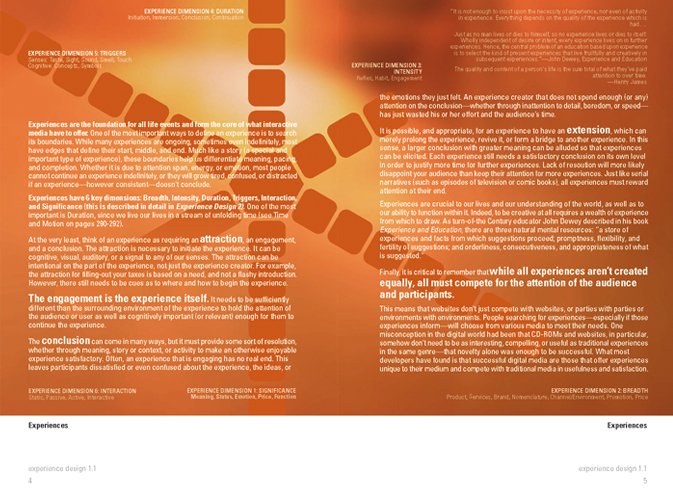
Experiencing the BookIn an article about Kenya Hara’s book, Designing Design, I quoted Hara’s opening words: “Verbalizing design is another act of design”. Words can be uttered and written, but they have to be designed into context, to accord them presence that can be perceived with our senses, and interpreted by each and every person in accordance with their worldview. In Hara’s view, a book is “information sculpture”. This line of thinking leads us to Nathan Shedroff’s book, which is not an ordinary reading book; the reading experience is different, it is an experience that challenges the inherent linearity of the book medium.The book is marked Version 1.1, a commonly used format in the world of computer software. It was preceded by Version 1 of the book, which was published in 2001, and Version 2 is due to be published in the near future. The book’s content gradually changes from one version to the next. The concepts and examples change, the book is updated and consequently changes. This raises the question, of which Shedroff is aware and which he addresses in his other book, Design Is the Problem: Why print a book like this? There is a sense that it cannot provide the necessary non-linear dynamics, and the links in it are dead, whereas an electronic version (PDF or website) could have functioned much better. The answer to the question is that in readers’ consciousness a place of honor is reserved for physical books, but the future will probably look quite different. The physical limitations of the printed book are acutely obvious, and evoke sad thoughts about its future. It is the struggle between the old, static world and the new, dynamic reality.
Nathan Shedroff is a central figure inthe design scene in the US. In 1995he was chosen by I.D. Magazine as one ofthe forty most influential designers today.He heads a unique MBA program in DesignStrategy, and has published several bookson experience design and sustainable design.His website includes links to books he haspublished or which are about to be published,as well as to his biography. Nathan Shedroffrecently came to Israel to give a workshopon meanings and experience design aspart of the Masters program in IntegratedDesign at Holon Institute of Technology,and during his visit he also delivereda lecture at Design Museum Holon.Click here for Nathan Shedroff’s website >>
The subject of Experience Design is manifested in experiencing the book. This book is not a container that holds information as an existing entity, neither does it seem to seek to inform the reader, or teach him through practice, but rather to evoke in him an opinion from experiencing it and its content.If Kenya Hara’s main focus is on the designed object in anticipation of its encounter with the reader, then Shedroff’s main focus is what happens between them, on their interaction.The book is a means, not an aim; the meaning of the reader’s experience is what needs to be designed. The book is designed, takes on a face, and gains meaning from the very experience of it.According to Shedroff, reality is divided into Online and Offline reality. Online is the reality on the internet, and Offline is the reality outside it. It is barely clear which of the two is more real, but the feeling is that there is a preference for the dynamic world of the internet. The entire book is composed of concepts arranged one after another, with each concept illustrated by an example from the Offline world and another from the Online world. Each concept and its attendant pair of examples. The concepts relate to the different topics that are listed hierarchically, headed by “Experience Design”, and followed by the topics composing it – Information Design, Interface Design, Interactive Design, The Senses, and Sensorial Design. Listed below each topic are concepts associated with and relating to it in one way or another. Thus, concepts relating to Information Design include: data, information, knowledge, wisdom, cognitive models, navigation, metaphors. Concepts relating to Interaction Design include: participants, feedback, control, creativity, communications, identity, storytelling, narrative structure and extension, point of view. The table of contents is the only place in the book where the full picture is revealed.The book has no preface or introduction, the reader can open it at random to read a brief description of a concept and its two attendant examples, and then jump to the next one. This kind of reading stimulates associative thinking, raises questions about the nature of the specific example – Is it a good example? Can I think of a better one? The imagination, as is its wont, sails off to other matters and finds correlations and contrasts between our own experiences and those presented in the book. When we understand something through an experience differently to the way we understood it before, then we have accorded it a different meaning. That is the nature of experiences; they raise thoughts, challenge opinions, and influence meanings. It seems that the manifesto of experience design derives from the meanings that are consolidated during experiences.
On Life ExperiencesOf the numerous examples in the book, I have chosen to present two cases, one Offline and the other Online. The first is a restaurant in New Orleans:
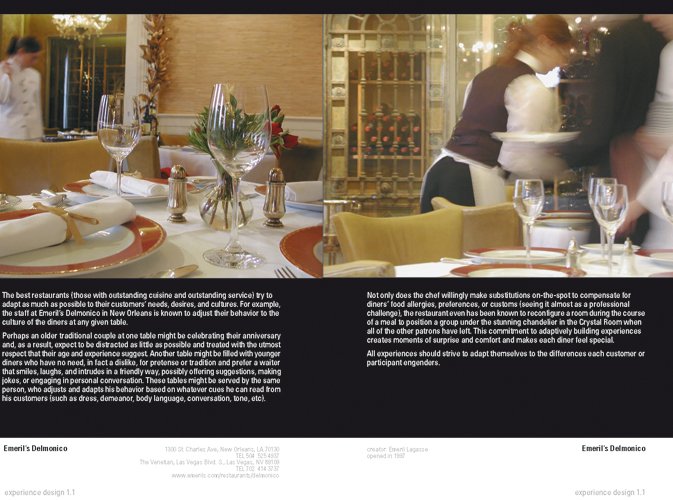
It is common practice for a restaurant to strive to acquire the status, reputation, and character that are associated with a particular lifestyle. It chooses to design the space, the furniture, tableware, menu, dishes, in a particular way to present its character and create a defined customer experience. This approach creates static inflexibility that does not enable a specific dialogue with each customer. By contrast, in our encounters with different people, we can adapt ourselves to each encounter in the design of our appearance, behavior, and manner of expressing ourselves without compromising our uniqueness. Flexibility is what this restaurant in New Orleans is renowned for, as they strive to design different customer experiences. Rather than a working to defined menu, diners can have a say in how the food is prepared, which is a challenge for the chef and an experience for the customer. Additionally, the waiters change and adjust their behavior and attitude from one customer to the next. Some customers might wish for as little intrusion as possible and expect a polite and respectful attitude, while others are happy for the waiter to offer suggestions and engage in light conversation. This requires attentiveness, sensitivity, and creativity in order to create the correct scenario for each customer. It is not only the food and the attitude that can be dynamic, but the space and its furnishings as well; the way the tables are arranged changes in accordance with the number of customers, the nature and size of the groups dining at the restaurant, and is adapted to the specific event or occasion. Thus, from being a static object with the character of a functioning machine, the restaurant becomes dynamic and organic, responding and offering itself in accordance with the conditions. The designer in this instance does not design a defined form for the restaurant, but rather scenarios of possible experiences.
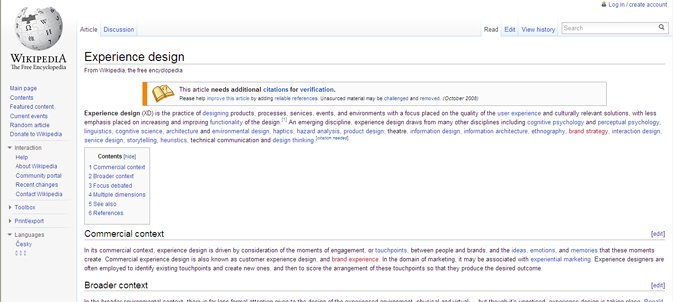
The Online Example, which highlights user involvement in creating experiences that exist by virtue of their active participation, is the renowned interactive internet encyclopedia, Wikipedia. Development of the encyclopedia is based upon the entries written and edited by its users. There are currently thousands of entries constantly being added on, in constantly growing numbers and languages. Any attempt to centrally supervise and control the information being written is impossible, so it is not managed from an attempt to control, but rather through participation and cooperation. The information constantly being added and edited does not come from a single source, but from a wide variety of sources that balance one another out. (For more on internet experiences from an anthropological perspective, I recommend Michael Wesch’s lecture. I was viewer number 1,656,516).The course of action whereby customers are involved in different levels of a company’s experience processes is being adopted by commercial companies seeking an active connection with their customers. This kind of connection can teach them a great deal about the motives and desires of their customers, and beyond that, it is a connection that is not merely reactive to the company’s actions, but also initiates and influences the customer experience provided by the company. The company exists from a partnership and dialogue with its community.
P.S. Experience Design – An Israeli Success StoryI wish to add here a “homegrown” example, namely the success story of Soda Stream in the US. Many of us are familiar with this company, which enjoyed considerable success for many years during which its product was a popular gift at family occasions. Over the years interest in the product gradually waned, and the company went into decline. In 2006 it changed hands, new management practices were adopted, and its value rose from a few million shekels to hundreds of millions. In terms of the product itself, nothing in its function changed, although over the years it has been redesigned and even had some limited editions, but that is not where the secret of its success lies. The big change stems from the management’s holistic view regarding its place in the environment in which it seeks to be positioned. The management designed new meanings for the company, the service it provides, and the product it manufactures. It has created a comprehensive experience for the consumer, the user, and the customer.The product is now considered a prestigious kitchen appliance; it solves the need to carry bottles of soft drinks, and joins the health trend by providing natural syrups. The overall meaning and significance of the experience, beyond the product and service, is adapted to the ecological values of the company’s customers since the system is resource-efficient and reduces polluting waste products. The experience the company offers is unique, ideological, applicable, and practical.
SummaryThis book presents the reader with a broad picture that deviates from accepted design boundaries. It is a picture of a dynamic worldview, of constant coming into being, and consequently the concepts we use have changed; what served us in the static world is no longer sufficient. We seek other concepts that emerge from the examples provided in the book. At the same time, it raises more questions than it provides answers. Anyone seeking to delve into the subject should read the book, Making Meaning, which Nathan Shedroff co-authored. The implications of concept design for experience design in the business and practical worlds are emphasized in this book. Shedroff notes that The Experience Economy, according to which the whole world is one big stage and every person experiences the dramatization of his or her play, formed the basis for his work.I shall conclude by quoting Peter Merholz on the Core77 website (Peter Merholz writes a blog about experience design and is an experience designer himself): “Experience IS the Product… and the only thing users care about”. He emphasizes the fact that what ultimately interests consumers is their experiences, and not the products themselves. Clearly experience design does not deviate from or oppose product design. It serves a broadening perspective with which to describe, examine, and design perspectives that enable providing better answers to consumer experiences.
Dr. Victor FrostigHolon Institute of Technology
